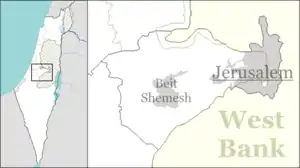Zekharia
Zekharia (Hebrew: זְכַרְיָה) is a moshav in central Israel. Located near Beit Shemesh, it falls under the jurisdiction of Mateh Yehuda Regional Council. In 2019 it had a population of 1,124.
Zekharia
זכריה زخاريا | |
|---|---|
 | |
 Zekharia | |
| Coordinates: 31°42′35″N 34°56′42″E | |
| Country | Israel |
| District | Jerusalem |
| Council | Mateh Yehuda |
| Affiliation | Moshavim Movement |
| Founded | 1950 |
| Founded by | Kurdish Jews |
| Population (2019)[1] | 1,124 |
Geography
Zekharia is located off the road between Bayt Jibrin and the Jerusalem-Jaffa highway. It is 268 meters above sea level. It is bordered on the southeast by the Elah Valley, about 5 kilometres (3.1 mi) southwest of Beit Shemesh. The mountain of Azekah can be seen directly to the south of the village.
History
Antiquity
Beth Zacharia (on a nearby hill) is said to have existed in Roman times.[2] According to legend, the body of the prophet Zechariah was found here in 415 CE and a church and monastery were established in the lower village by the same name.[3] The Madaba Map displays the lower town as the burial site of the prophet Zechariah.[4]
Ottoman era
In the Ottoman era, Az-Zakariyya was an Arab village in the Jerusalem corridor under the administrative jurisdiction of Bayt Jibrin. Under the Mamluks, the village was a dependency of Hebron, and formed part of the waqf supporting the Ibrahimi Mosque.[5]The villagers obtained their drinking water from two communal wells:- al-Saflani well which was drilled next to Wadi 'Ajjur, and al-Sarara well located north of the village.[6]
State of Israel
In the 1948 Arab–Israeli War, Az-Zakariyya was the longest lasting Palestinian Arab community in the southern Jerusalem Corridor.[7] The villagers were evicted by the Israelis in three different phases, last eviction was carried out on June 9, 1950, on the orders of David Ben-Gurion, Moshe Sharett and Yosef Weitz, and most ended up on the West Bank.[8]
In 1950 Moshav Zekharia was established by Kurdish Jewish immigrants on the village site.[9] During the 1960s, most of the older buildings in the village were destroyed to make room for the new.[10]

In 1992, Walid Khalidi described the remaining structures: "The mosque and a number of houses, some occupied by Jewish residents and others deserted, remain on the site. Large sections of the site itself are covered with wild vegetation. The mosque is in a state of neglect and an Israeli flag is planted on top of the minaret. [..] One of the occupied houses is a two-storey stone structure with a flat roof. Its second story windows have round arches and grillwork. Parts of the surrounding lands are cultivated by Israeli farmers."[9]
Landmarks and culture
The tomb of Zecharia, which has been attributed to both the Hebrew prophet Zecharia and Zechariah, father of John the Baptist, is located on the moshav. The site is mentioned in sources as early as the fourth century, in the writings of Sozomenos, and it appears on the Madaba map.
In the 1970s, there was a resurgence of Jewish interest in the site, which became a pilgrimage destination for Jews from Iraq, Iran, Cochin, India and elsewhere, who prayed there and lit candles.[11]
Gallery
 Homes in Moshav Zekharia
Homes in Moshav Zekharia Remains of a minaret and mosque
Remains of a minaret and mosque Az-Zakariyya, pre-1926[12]
Az-Zakariyya, pre-1926[12] Main synagogue
Main synagogue View from southeast and the Elah Valley
View from southeast and the Elah Valley Residential neighborhood on adjacent hilltop
Residential neighborhood on adjacent hilltop House in Zekharia
House in Zekharia Public park
Public park
References
- "Population in the Localities 2019" (XLS). Israel Central Bureau of Statistics. Retrieved 16 August 2020.
- Josephus, Antiquities (Book xii, chapter ix, verse 4)
- Petersen, 2001, p. 320
- See p. 138 in: Tsafrir, Yoram (1986). "The Maps Used by Theodosius: On the Pilgrim Maps of the Holy Land and Jerusalem in the Sixth Century C.E.". Dumbarton Oaks Papers (Trustees for Harvard University). 40: 129–145. doi:10.2307/1291534. JSTOR 1291534.
- Mujir al-Din, 1876, pp. 230-1. Cited and translated in Petersen, 2001, p. 320
- Khalidi, 1992, pp. 224–225
- Morris, 2004, p. 521
- Mordechai Bar-On, officer in charge of the eviction. Quoted in Morris, 2004, p. 521
- Khalidi, 1992, p. 226
- Arnon Shai (2006). "The Fate of Abandoned Arab Villages in Israel, 1965-1969". History and Memory. 18 (2): 86–106. doi:10.2979/his.2006.18.2.86.
- Sacred Space in Israel and Palestine: Religion and Politics, ed. Marshall J. Breger, Yitzhak Reiter and Leonard Hammer
- Khalidi, 1992, p. 206
Bibliography
- Khalidi, Walid (1992). All That Remains: The Palestinian Villages Occupied and Depopulated by Israel in 1948. Washington D.C.: Institute for Palestine Studies. ISBN 978-0-88728-224-9.
- Morris, Benny (2004). The Birth of the Palestinian Refugee Problem Revisited. Cambridge: Cambridge University Press. ISBN 978-0-521-00967-6.
- Petersen, Andrew (2001). A Gazetteer of Buildings in Muslim Palestine (British Academy Monographs in Archaeology). 1. Oxford University Press. ISBN 978-0-19-727011-0.